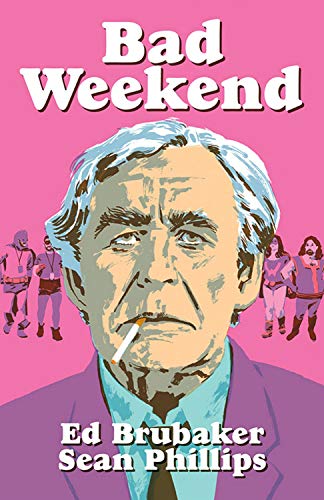Ed Brubaker and Sean Phillips, with colours by Jacob Phillips, Bad Weekend (Image 2019)
––––––, My Heroes Have Always Been Junkies (Image 2018)
Scanning my shelves after reading Charlotte Wood’s The Weekend (blog post to come when the Book Group meets), I decided to stick with the title and read a couple of the quality comics I was given for Christmas presents (Bernhard Schlink’s The Weekend possibly to come).
These two handsome stand-alone books (‘novellas’) are spin-offs from the Criminal series of comics created between 2006 and 2012 by Ed Brubaker (writer) and Sean Phillips (art). According to Wikipedia, ‘The series is a meditation on the clichés of the crime genre while remaining realistic and believable.‘ That description is pretty accurate for these two books.
Bad Weekend is set in the world of comic artists. The narrator is charged with being the minder for a cantankerous, sexist, drunken old man who has been invited to a convention to receive a major award – because he is also an artist of genius. The narrator has been the old man’s assistant years earlier, and has been specifically asked for by him on this occasion. It turns out (of course) that the old man is completely uninterested in the award, but wants the young man’s help in finding some priceless original artwork that has been stolen from him. Set in the 1980s and 1990s, the art has a slightly surreal noir feel to it (surreal because of the costumed convention-goers, noir because of the dark world of art theft and intrigue). There’s a nice twist at the end, which probably would have been obvious to anyone who wasn’t, like me, just along for the ride. I should add that the ride involves genuine pathos as we discover the causes of the old man’s vileness.
My Heroes Have Always Been Junkies should surely win a Most Provocative Title award. It turns out that like Bad Weekend this novella has a fairly straightforward plot involving criminal intrigue. A young woman with a heavy drug habit is sent to an expensive rehab clinic, but has no intention of getting clean. She sets her sights on a handsome young man and persuades him to run away with her from the clinic and from the constraints of their lives. She is, as she says, a bad influence. But there are hints that she is much worse than that – and these hints are realised. It’s pulp.
The present-time narrative, mostly in full colour, is intercut with the young woman’s back story in moody monochrome, in particular the way, after her mother died, possibly of an overdose, she became fascinated by singers and pop stars who were heroin users. For me, the effect was a reinstatement of parts of famous lives that have been quietly erased or glossed over (David Bowie, John Lennon, Jean-Paul Sartre), and an attention to details of lives I knew very little about (Billie Holliday, Gram Parsons). So it’s pulp, but there’s plenty of nutritious stuff there.



